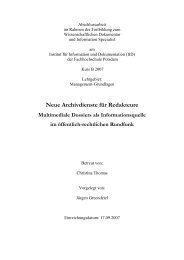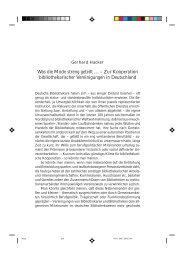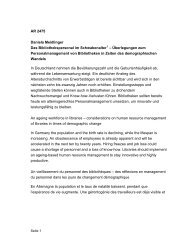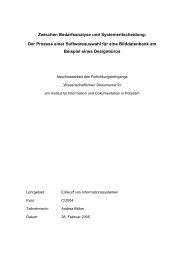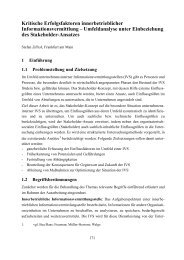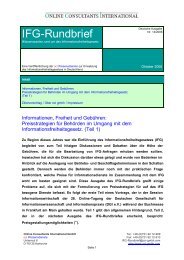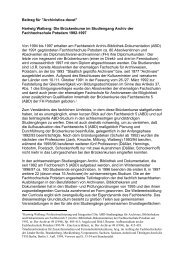PDF(886K) - Wiley Online Library
PDF(886K) - Wiley Online Library
PDF(886K) - Wiley Online Library
Create successful ePaper yourself
Turn your PDF publications into a flip-book with our unique Google optimized e-Paper software.
Circularity, i.e., the definition of a concept with the help of<br />
the same concept, which—as a mediate circle by now—can<br />
now be found across several definition steps, is to be avoided.<br />
To define an unknown concept via another, equally unknown<br />
concept (ignotum per ignotum) is of little help. The inadequacy<br />
of definitions shows itself in their being either too<br />
narrow (when objects that should fall under the concept are<br />
excluded) or too wide (when they include objects that belong<br />
elsewhere). In many cases, negative definitions (a point is that<br />
which has no extension) are unusable, as they are often too<br />
wide (Menne, 1980, p. 32). A definition should not display<br />
any of the concept’s superfluous properties (Menne, 1980,<br />
p. 33). Of course, the definition must be precise (and thus not<br />
use any figurative truisms, for example) and cannot contain<br />
any contradictions (such as blind viewer). Persuasive definitions,<br />
i.e., concept demarcations aiming for (or with the side<br />
effect of) emotional reactions (e.g., to paraphrase Buddha,<br />
Pariah is a man who lets himself be seduced by anger and<br />
hate, a hypocrite, full of deceit and flaws…; Pawłowski, 1980,<br />
p. 250), are unusable in knowledge representation. The most<br />
important goal is the definition’s usefulness in the respective<br />
knowledge domain (Pawłowski, 1980, p. 88). In keeping with<br />
our knowledge of vagueness, we strive not to force every single<br />
object under one and the same concept, but sometimes<br />
define the prototype instead.<br />
From the multitude of different sorts of definition (such<br />
as definition as abbreviation, explication, nominal, and real<br />
definition), concept explanation and definition via family<br />
resemblance are particularly important for knowledge<br />
representation.<br />
Concept explanation starts from the idea that concepts are<br />
made up of partial concepts:<br />
Concept = df Partial Concept 1 , Partial Concept 2 ,...<br />
Here one can work in two directions. Concept synthesis<br />
starts from the partial concepts, while concept analysis<br />
starts from the concept. The classical variant dates from<br />
Aristotle and explains a concept by stating genus and differentia.<br />
Aristotle works out criteria for differentiating concepts<br />
from one another and structuring them in a hierarchy. The<br />
recognition of objects’ being different is worked out in<br />
two steps; initially, via their commonalities—what Aristotle,<br />
in his “Metaphysics,” calls “genus”—and then the differences<br />
defining objects as specific “types” within the genus<br />
(Aristotle, 1057b 34 et seq.). Thus, a concept explanation<br />
necessarily involves stating the genus and differentiating the<br />
types. It is important to always find the nearest genus, without<br />
skipping a hierarchy level.<br />
What determines the differentiation of a genus’ types?<br />
Aristotle distinguishes between two aspects—the arbitrary<br />
nature of an object (i.e., that horses have tails while humans<br />
do not) on the one hand, and the fundamental, specific properties<br />
that make a difference on the other (e.g., that humans are<br />
able to reason, while horses are not). In the Middle Ages this<br />
thesis of Aristotle’s was summed up in the following, easy<br />
to remember phrase (Menne, 1980, p. 28): “Definitio fit per<br />
genus proximum et differentiam specificam.” Hence, concept<br />
explanation works with the following partial concepts:<br />
Partial Concept1 : Genus (concept from the directly<br />
superordinate genus),<br />
Partial Concept2 : Differentia specifica (fundamental<br />
difference to the sister concepts).<br />
The properties that differentiate a concept from its sister<br />
terms (the concepts that belong to the same genus) must<br />
always display a specific, and not an arbitrary property<br />
(accidens). A classical definition according to this definition<br />
type is:<br />
Homo est animal rationale.<br />
Homo is the concept to be defined, animal the genus concept,<br />
and rational the specific property separating man from<br />
other creatures. It would be a mistake to define mankind via<br />
living creature and hair not blond, since (notwithstanding<br />
jokes about blondes) the color of one’s hair is an arbitrary,<br />
not a fundamental property.<br />
The fact that over the course of concept explanations, over<br />
several levels from the top down, new properties are always<br />
being added means that the concepts are becoming ever more<br />
specific; in the opposite direction, they are getting more general<br />
(as properties are shed on the way up). This also means<br />
that on a concept ladder properties are “inherited” by those<br />
concepts further down. Concept explanation is of particular<br />
importance for KOS, as their specifications necessarily<br />
embed the concepts in a hierarchical structure.<br />
In concept explanation, it is assumed that an object wholly<br />
contains its specific properties if it belongs to the respective<br />
class; the properties are joined together via a logical AND.<br />
This does not hold for the vegetable-like concepts, where<br />
we can only distinguish a family resemblance between the<br />
objects. Here the properties are joined via an OR (Pawłowski,<br />
1980, p. 199). If we link concept explanation with the definition<br />
according to family resemblance, we must work with<br />
a disjunction of properties on certain hierarchical levels.<br />
Here, too, we are looking for a genus concept, e.g., for<br />
Wittgenstein’s game. The family members of game, such as<br />
board game, card game, game of chance, etc., may very well<br />
have a few properties in common, but not all. Concepts are<br />
always getting more specific from the top down and more<br />
general from the bottom up; however, there are no hereditary<br />
properties from the top down. On those hierarchy levels that<br />
define via family resemblance, the concepts pass on some of<br />
their properties, but not all.<br />
Let us assume, for instance, that the genus of game is<br />
leisure activity. We must now state some properties of games<br />
in order to differentiate them from other leisure activities<br />
(such as meditating). We define:<br />
Partial Concept1 /Genus: Leisure Activity<br />
Partial Concept2 /Differentia specifica: Game of Chance v<br />
Card Game v Board Game v ...<br />
1956 JOURNAL OF THE AMERICAN SOCIETY FOR INFORMATION SCIENCE AND TECHNOLOGY—October 2010<br />
DOI: 10.1002/asi



